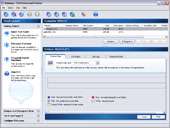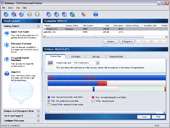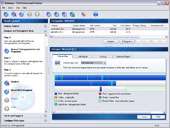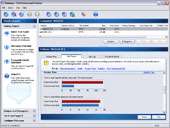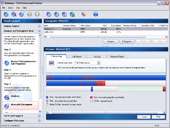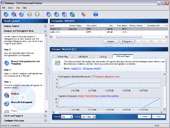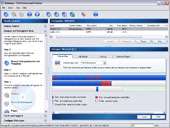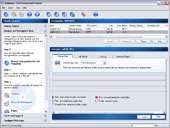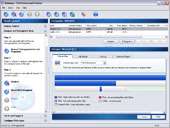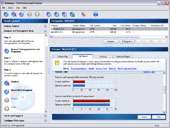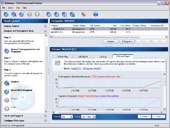- Qualcomm Launches Snapdragon 4 Gen 2 Mobile Platform
- AMD Launches Ryzen PRO 7000 Series Mobile & Desktop Platform
- Intel Launches Sleek Single-Slot Arc Pro A60 Workstation Graphics Card
- NVIDIA Announces Latest Ada Lovelace Additions: GeForce RTX 4060 Ti & RTX 4060
- Maxon Redshift With AMD Radeon GPU Rendering Support Now Available
Diskeeper 10 Professional Premier

Diskeeper is back with their top notch Defragmentation software. The new version takes a lot of features that have helped make the software so great, and made them even better. You now will even have the capability of defragging computers on your network. Let’s take a look at the latest version and see if it’s worth your hard earned money.
Page 2 – Defragging capabilities
What all this boils down to is this: Diskeeper 10 Pro Premier will allow you run scheduled defragmentation of local and networked drives, run boot time defrags of local drives and defragment huge volumes with ease. It will allow up to 8 simultaneous defragmentation jobs to run at once (while this is great for multiple disk systems you would be better served to que partitions on a single disk) and it offers some very advanced defragmentation methods such as I-FAAST and large file optimization.
When you first open Diskeeper you’re greeted a blank volume map with the default map view set to file performance. The performance map view differs from the file structure map view in that it doesn’t show you the different types of files and the folder structure. Instead it shows your files and folders as one of three basic types, high performing files and folders, low performing files and folders and low performing system files. This is nice as it clears up any confusion about whether your folder structure is mucking up your disk performance. As you can see in the second and third screenshots, although my folders are a bit spread around the disk there is no performance hit from this.
After you’ve analyzed the disk, clicking the job report tab will show you the approximate amount of time you’ll save accessing the files on your drive and your drive in its entirety. As you can see from my example the time to read the fragmented files on my HDD would improve by nearly 90 seconds and the time to read all files will pick up close to a 2.5 minute improvement. Where will this help? Well, since most of the files on your HDD that are getting this badly fragmented are the browser cache you’ll see an improvement when you surf the web since your drive won’t spend as much time doing seeking when you’re going from one page to the next and if you do a lot of digital media work then you’ll be putting those files in order which will really help in speeding up those tasks. Also after installing games, app’s or doing windows updates you’ll see improvements in the performance of your system by doing a good defrag by putting all the new files on the disk in such a way that they are optimized for reading.
Clicking the left Analyze and Defragment button opens up the menu for manual defragmentation (on a side note, you can analyze and defragment a drive by simply right clicking it in the top pane and choosing the appropriate choice). The button choices are what you’d expect to find, Analyze, Defragment, Pause and Stop. The Historical Report tab will show you the history of your defragmentation and fragmentation in a simple line graph dating from the day you install the software to the current date. This is pretty handy for keeping tabs on how many fragments you eliminate and the trend of fragmentation on your drives.
During manual defragmenting you can see the files being moved and their progress by looking at the bottom of the window below the map. If you’ve got multiple drives you can select one of them and start a job on it to get everything out of the way at once to help maximize your time.
One thing I’d like to say about Diskeeper 10 versus the default Windows defraging tool or even Diskeeper 8 for that matter, during defragmentation you’ll normally see your PC becoming sluggish and stop responding or respond slowly. With Diskeeper 10 this is a thing of the past. During defragmentation my PC responded completely normally and it’s completely transparent to the user. Other than the tray icon and taskbar icon once you’ve minimized the window you’ve got no clue that anything is happening. Another nicety is an option called Disk Priority (I’ll illustrate this in a minute in the options part of the review) that allows you to have Diskeeper pause defragmenting at any time that the disk usage by the user would interfere with PC performance. This means that you can surf the web and download files or transfer files from one drive to your HDD or even install a program during defragmentation and still have no clue that anything’s running in the background.
After defragmentation is over a quick look at the map shows if any trouble spots remain. Overall mine looks OK with just 4 non-optimized system files. Glancing at the other tabs reveals how well the defragmentation has helped my system’s performance and how this fits in historically. If you’ve got bad fragmentation of the system files you can run the boot time defragmenter which leads me into the next section of the review:
|
|
Support our efforts! With ad revenue at an all-time low for written websites, we're relying more than ever on reader support to help us continue putting so much effort into this type of content. You can support us by becoming a Patron, or by using our Amazon shopping affiliate links listed through our articles. Thanks for your support!




